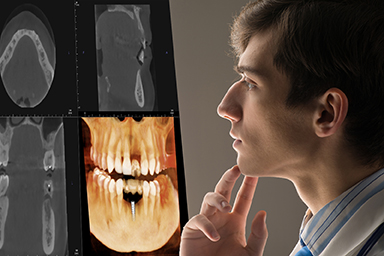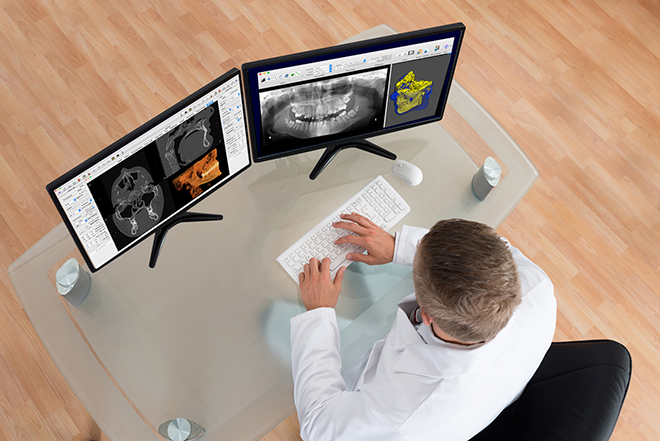Considering a Career as an Oral & Maxillofacial Radiologist?
How to become an Oral and Maxillofacial Radiologist
OMR requires postdoctoral training. These programs are offered at 10 universities in the United States and Canada; for more information about these programs click here.
There are several different levels of training available for Oral & Maxillofacial Radiology, they include:

- Certificate programs (2-2.5 years)
- Master's Degree programs (3 years)
- PhD programs (~5 years)
|
Career opportunities in Oral and Maxillofacial Radiology
|
|
The Oral and Maxillofacial radiology programs prepared one for a career in a variety of settings. OMRs can teach in dental/medical schools, conduct research, or participate in private practice/teleradiology. Many OMRs combine some or all of these practice settings. Exciting possibilities in both clinic-based and home-based private practice are available across the country. For more information about careers in Teaching/Education, Research, & Practice Practice see below.
|
OMR Careers in Teaching/Education
|
|
 The majority of OMRs are employed by dental schools. Responsibilities include didactic and clinical education of predoctoral dental, dental hygiene, and/or graduate dental students. OMRs are also responsible for establishing policies regarding radiographic selection criteria, radiation safety, and quality assurance. They make decisions regarding the purchase of equipment, and other aspects of clinical operation. As faculty members, they also participate on committees at the dental school or university level. The majority of OMRs are employed by dental schools. Responsibilities include didactic and clinical education of predoctoral dental, dental hygiene, and/or graduate dental students. OMRs are also responsible for establishing policies regarding radiographic selection criteria, radiation safety, and quality assurance. They make decisions regarding the purchase of equipment, and other aspects of clinical operation. As faculty members, they also participate on committees at the dental school or university level.
On a typical day, the OMR faculty member might teach a class, conduct a small group seminar on radiographic imaging or interpretation, supervise students in radiographic technique, supervise interpretation of patient images with students, consult on a challenging case, interpret CBCT Scans and/or conduct research.
Some OMRs have appointments at medical schools or in hospital Radiology departments. These environments provide access to imaging modalities not usually included in dental schools, such as CT, MRI, and arthrography. Hospital-based OMRs participate in case conferences for neuro- and head and neck radiology. They are exposed to more trauma and neoplastic disease than dental school-based radiologist. OMRs working in academic medical centers also teach medical students and radiology residents.
Education is a quite fulfilling career. The need for OMRs in schools of dentistry is growing more acute, paralleling the increasing shortage of dental faculty members in general. Currently employment opportunities for OMRs in education is good.
Click here for the most recent academic salary statistics provided complimentarily by 
|
OMR Careers in Private Practice
|
|
 Some OMRs participate exclusively in private practice. They may practice in an imaging center, a dental clinic, or at home via teleradiology (patient scans and reports are relayed via the internet). These practitioners mainly provide CBCT interpretation, but also consult on MRI (usually TMJ cases) and challenging intraoral and panoramic radiographs. CBCT interpretation is usually requested for suspected pathology, implant consultations, and TMJ evaluation. Some OMRs affiliate with radiology practices that offer a wide range of procedures such as nuclear medicine and ultrasound. Some OMRs participate exclusively in private practice. They may practice in an imaging center, a dental clinic, or at home via teleradiology (patient scans and reports are relayed via the internet). These practitioners mainly provide CBCT interpretation, but also consult on MRI (usually TMJ cases) and challenging intraoral and panoramic radiographs. CBCT interpretation is usually requested for suspected pathology, implant consultations, and TMJ evaluation. Some OMRs affiliate with radiology practices that offer a wide range of procedures such as nuclear medicine and ultrasound.
Most OMRs in academic settings provide CBCT interpretation as well; in an academic setting it is called "Faculty practice." Dental schools that have graduate programs in periodontics and prosthodontics or that operate orofacial pain centers often provide many patients for the OMR.
|
OMR Careers in Research
|
|
Scholarly activity is often required of faculty members, therefore most research in radiology is conduct by dental/medical school faculty. The type of research and time allotted for it varies depending on the mission of the institution, the availability of patients and equipment, and the interests of the radiologist. OMRs at some universities conduct investigations into new imaging technology, such as detailed evaluations of the physical and mechanical basis of imaging systems or comparative measures of their diagnostic efficacy. Other researchers examine the biologic effects of radiation. Some institutions make use of their extensive patient populations and generate clinical reports that advance our knowledge of the patterns of disease. Many dental school provide money to support the scholarly activity of their faculty members. Grant money for research is also available from private industry and organizations such as the Radiological Society of North America, which provides Scholar Grants and Seed Grants for OMRs in the early years of an academic appointment. Researchers with more experience may receive funding from the National Institute for Dental and Craniofacial Research. The opportunities for creative activity are limited only by the imagination of the radiologist.
|
Additional information
|
|
A career as an oral and maxillofacial radiologist can be an enriching and professionally fulfilling one. If you would like more information about this exciting specialty, please contact:
Sanjay Mallya, Past President
American Academy of Oral and Maxillofacial Radiology
Email: [email protected]
|
|